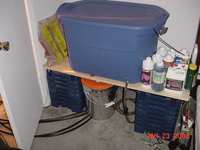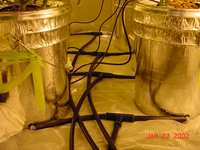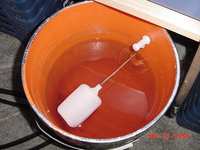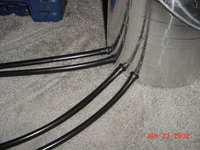How do I build an External Reservoir and Control
Bucket?
| Added by:
MedMan Last edited by:
ranger2000 Viewed: 102 times |
Rated by 36 users:
9.35/10 |
Contributed by: Forty Six and Two
It seems a lot of people are interested in how I
built my set-up, so I?ll give as many details as I can
covering the construction and operation aspects of
plumbing an external reservoir with a controller bucket
in DWC. I won?t cover the actual building of the bubbler
buckets, this can already be found in the
FAQ
section on bubbler information. This set-up took me
quite a while to construct, many parts were bought and
never used, basically trial and error until I got it
right. Only a few people on this board run DWC with a
controller and external reservoir. I will be explaining
how to build this set-up slightly different than mine,
as I have discovered a few problems that could use some
improvement. First off, let?s cover the supplies and
tools you?ll need, this took me quite some time to
figure out what will work and what wouldn?t.
What you will need.. 13 X 1/2? Rubber
Grommets - 3 box of 5@$1.49 = $4.47 8 X ? Barbed
elbow fittings 8@$1.38 = $11.04 5 X ? Barbed
straight fittings 5@$.88 = $4.40 Roll of ? Poly
Water line = $5.76 1 X ? On/Off valve = $1.95
5/8? & ? bit =$10.39 + $7.98 = $18.37
Rubbermaid reservoir(33 gal in this case) = $14.97
G.H. Float valve = $14.95 4 X ? Tee-sleeve
fittings 4@$2.14 = $8.56 Boxcutter = $2.39 Vinyl
tubing = $2.96 Power Drill with 5/8? & ? bit
A water pump of some kind is good for changing out
the nutrients, I use a Rio 1100, and it seems to be
adequate.
 NOTE: Make sure your fittings and poly
line make a tight fit before leaving the store, they
make different ? diameters, O.D. and I.D., inside and
outside diameter.
NOTE: Make sure your fittings and poly
line make a tight fit before leaving the store, they
make different ? diameters, O.D. and I.D., inside and
outside diameter.
Obviously, this set-up is
designed to be leak free, and if you do as I did, you
can accomplish this as well. This is easily done with a
steady hand when using your drill. You must be very
careful when drilling your holes in your buckets. My
5/8? bit has a corkscrew on the tip for stabilization; I
recommend these for a good clean cut. Hold your drill
perfectly straight up, aim about -1/2? above the bottom
of the buckets, then drill all the way through in a
fast, steady motion, at the drill?s full-throttle. It?s
best to drill the holes at the bottom to ensure full
water pressure, which is applied by gravity(hole
location applies to plant and control buckets). I had
trouble getting watertight seals until I came across a
drill bit with a screw on the very end to lead into your
cuts. After that, getting perfect cuts was very easy. If
there are any frays or bits of plastic left around the
hole you just made, cut them off carefully with a
box-cutter, making sure not to damage the edges of the
hole, which will soon ensure a watertight seal with your
grommets. Do this to all of your buckets, and to your
controller bucket. The amount of holes you drill on your
controller bucket will depend on how many buckets you
have. I have 8, so I drilled 4 holes in the control
bucket, so each outgoing line can feed 2 buckets each.
After you have made all your holes-- carefully I
hope-- it is now time to insert the rubber grommets.
This can be quite painful if you don?t have tough hands.
The trick is to get a small part inserted first, then
work it in all the way around in a circle until you get
back to where you started. If everything went right, you
should have half of the grommet inside the bucket and
half outside. Reach inside your bucket, grab the edges
of the grommet and pull any part of the lip that didn?t
go through from the outside. Also make sure the inner
ring is completely flush with the inside wall, otherwise
they might not seal watertight. I also insert a flathead
screwdriver into the grommets, making sure the inside of
the grommet is as close to the edge of the drilled hole
as possible. Do this to all the buckets, your reservoir,
and to your control bucket as well.
Now it?s
time to insert the barbed fittings. You may need a small
amount of Vaseline to get these babies in. If you don?t,
then you may have drilled too big of a hole and
therefore will not be watertight. Wipe off the excess
that oozes out of the sides. Use the straight barbed
fittings for the control bucket, and the elbow-barbed
fittings for the plant buckets. Place the fittings in
all of your buckets. Make sure that the buckets?
fittings face the direction of the fitting of the bucket
it will be linked to.
Connections..
 To plumb all these things
together is quite simple. This is where this set-up will
differ from my current one. As soon as my plants come
down, I?m going to make these changes to my own system.
You can see that all my water lines run down the centre
of my room and in between all of the buckets,
overlapping a line here and there. This overlapping of
the water lines causes very slight differences in water
level between buckets. This may not matter to you, but
if you?re a freak when it comes to details, like me, it
will matter. To prevent this, link each bucket to the
one in front of or behind it, instead of the one across
from it in the other row. This way, you could run the
lines to each set of buckets without overlapping any
other lines, and therefore, creating an equal water
level from bucket to bucket. Now all of your buckets
will retain the same water level as your control bucket.
So instead of all 4 lines from the control bucket
running down the centre, 2 will go to each side. You
should make sure you get the right type of t-fittings
for your poly line, I found that the barbed ones, or at
least the ones I purchased, were not that great for
holding back water. The ones I found that worked the
best, the ones in the pics, are the type that go around
the poly line itself. Also be sure that these fittings
fit the line you purchased, there are 2 different kinds
of ? lines and fittings as mentioned above. After you
cut your line to the desired length, you can now begin
to hook everything together.
The
control Bucket..
 This is a very simple concept
and easy to build, although there?s not that much
information out there regarding construction. How does
it work? The control bucket takes in nutrients via
gravity from the elevated reservoir, and fills until the
point where the float closes the valve, preventing any
more nutes from pouring in. I am going to describe how
to do this using a General Hydroponics float valve,
which are around $10-15 at most hydro stores. Using a ?
drill bit, drill a hole right above the first ridge from
the bottom of the control bucket. You need not be as
careful this time when drilling, as the hole itself will
not have to hold any water back, and no grommet will be
needed. Make sure you make the hole just enough above
the ridge in order to have room for the valve?s bolt.
The float should have a small packet of cement attached
when you buy it. Use this on the float valve to secure
the connection of the valve to the bucket. From the
inside, insert the valve?s threads through the hole you
drilled, and screw on the provided barbed fitting on the
outside. You may have to bend the float?s arm a bit, in
order for it to fit into the bucket. It doesn?t matter;
you?ll have to bend it more to get the right water
level. Adjusting the water level is very simple; bend
the float arm until the float reaches the desired level.
Run a ? poly from your reservoir, to your newly
constructed control bucket. Put a ? On/Off valve in
this line to make changing nutes a bit easier. The
reservoir can be fitted with a grommet and barbed
fitting, just like the buckets, and need to be elevated
enough so that the bottom is above the float valve?s
connection in the control bucket. I use a Rio 1100 water
pump to cycle nutrients in the reservoir, and to change
out the nutrients in the system.
To change out
the nutrients in this system, simply place a water pump
in the control bucket, and have it pump into an empty
bucket. You?ll have to make several trips to get this
done. Also, you?ll have to wait for the control bucket
to fill back up with nutes, which comes in from the
plant buckets. Most of the nutrient gunk that builds up
in the system can be removed after it?s sucked into the
control bucket. The only thing about changing the nutes,
you can only get the system?s water level down to the
level of the water pump?s intake. The rest can be
removed by hand if needed. I usually have a full
reservoir of fresh nutes waiting to be pumped in after I
drain everything out.
A look inside the
bucket..

The Outgoing lines..

|
| Last modified: 15:03 - Mar 12,
2002 |
| |